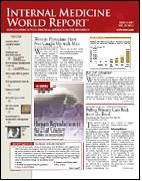Sargramostim%u2019s Efficacy in Crohn's Disease: New Clues to the Pathogenesis?
Sargramostim’s Efficacy in Crohn's Disease: New Clues to the Pathogenesis?
A 180° Turn in Thinking, Treatment
NEW ORLEANS—Results from a recent study using sargramostim (Leukine) in patients with Crohn’s disease have raised new questions and possibly charted new answers that may lead to a novel approach to the treatment of this condition, researchers reporting at Digestive Disease Week suggested.
After discontinuation of sargramostim (Leukine) treatment in patients with moderate-to-severe active Crohn’s disease, improvements in clinical response, remission rate, and quality of life have persisted in a significant number of patients.
“We looked at the period of 8 weeks following the end of the original clinical trial,” investigator Brian Dieckgraefe, MD, Division of Gastroenterology, Washington University School of Medicine, St Louis, Mo, told Internal Medicine World Report (IMWR). “One of the things that you like to see in trials is a persistent activity at time-intervals that are meaningful in a clinical sense, and an ongoing separation between the treatment and the placebo groups. The 30-day follow-up data show solid differences between patients in terms of end points, a response of more than 70 points and even more than 100 points in Crohn's Disease Activity Index (CDAI), as a well as ongoing remission. What we see is a very clear treatment effect, maintained more than one month beyond active treatment.”
Sargramostim, a man-made form of the naturally occurring protein granulocyte- macrophage colony-stimulating factor (CSF), causes bone marrow cells to multiply and form colonies similar to other drugs in this CSF class. Sargramostim, a hematopoietic growth factor, is used for the treatment of several autoimmune conditions and is FDA-approved for the treatment of different types of cancer.
The drug has previously shown clinical response in patients with Crohn’s disease; the intriguing question is whether defects in innate immunity plays a role in the pathogenesis of Crohn’s disease.
In this new study, a total of 124 patients with moderate-to-severe active Crohn’s disease (CDAI scores, ³220 and £475, respectively) were treated for 8 weeks with sargramostim, 6 µg/kg daily (n = 81), or placebo (n = 43).
Participants were evaluated for changes in CDAI score, quality of life, and adverse events at end of treatment as well as 30 days after treatment termination. Study protocol allowed for continuing use of stable doses of antibiotics or 5-aminosalicylic acid during the trial and follow-up period; steroid and immunosuppressant use was prohibited. Baseline characteristics were similar in both groups (median baseline, CDAI score = 300).
Significantly more patients receiving sargramostim than those in the placebo group had reduced CDAI scores by ³100 points: 48% (39/81) versus 26% (11/43), respectively (P = .013). Also, remission rates were greater with the active drug than with placebo at end of treatment: 40% (32/81) versus 19% (8/43), respectively (P = .014). These outcomes were maintained through the follow-up period.
“More sargramostim patients achieved a lowering of CDAI of 70 points or more at follow-up as well, even though this level of significance was not observed at end of treatment,” the investigators noted.
The drop in disease severity persisted, even though cell counts returned to baseline median levels. In addition, Inflammatory Bowel Disease Questionnaire scores were significantly better in patients receiving sargramostim compared with placebo at day 29 and at follow-up.
Mild-to-moderate injection-site adverse reactions (onset, week 2, 5-10/patient total) and bone pain (onset, day 3, duration 7 days) appeared more often in the active treatment group. “No difference in Crohn’s disease exacerbation was observed after therapy,” the investigators observed.
“The striking differences between the groups at the end of 8 weeks of treatment endured. The continuing emergence of this kind of data reinforces our belief that we need to look at a new understanding of the pathogenesis of Crohn’s disease and, therefore, a new way to approach treatment,” said Dr Dieckgraefe.
“The most exciting news here is that this drug works for patients with Crohn’s disease,” investigator John Valentine, MD, associate professor of medicine, University of Florida School of Medicine, Gainesville, Fla, told IMWR. “But if it works by stimulating the immune system, that is a 180 degree turn from how we think of treating Crohn’s. This could revolutionize therapy for this disease if this turns out to be true.”
Evaluations of follow-up to 6 months post-therapy are underway.
